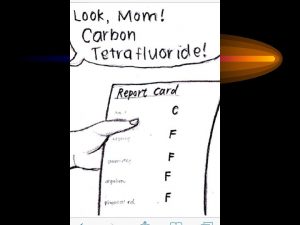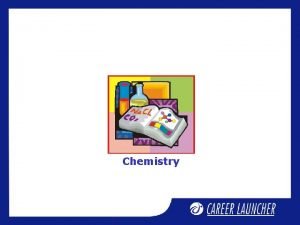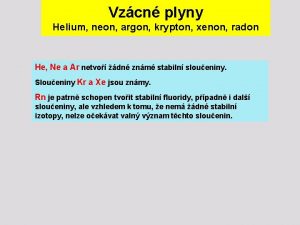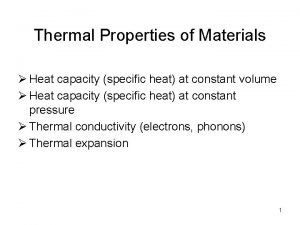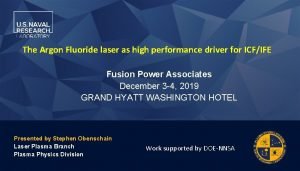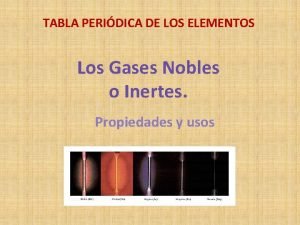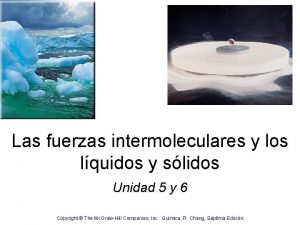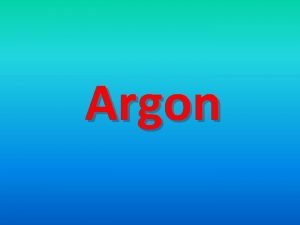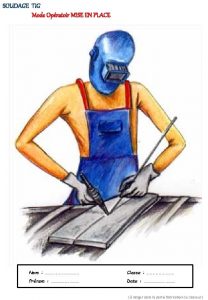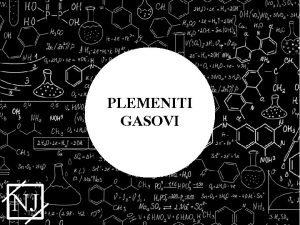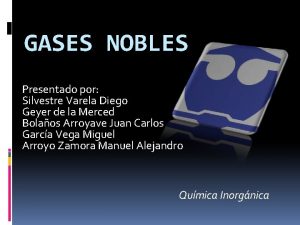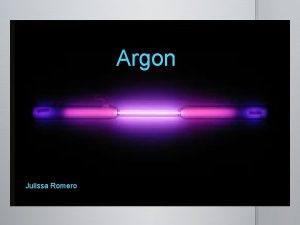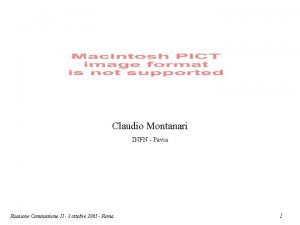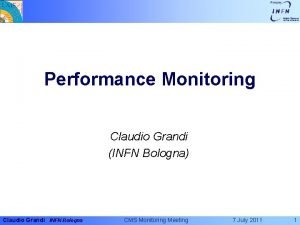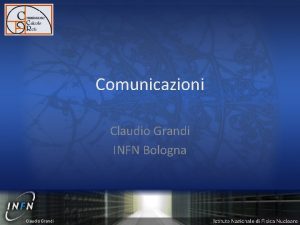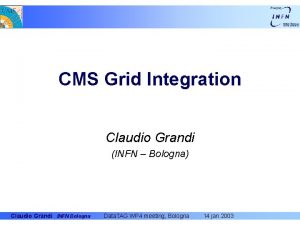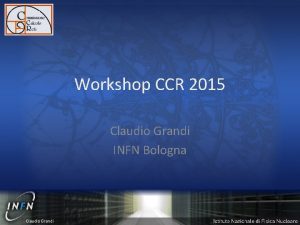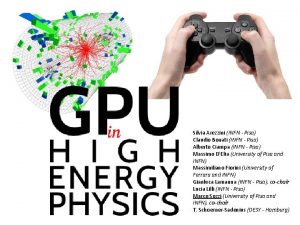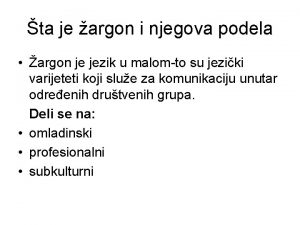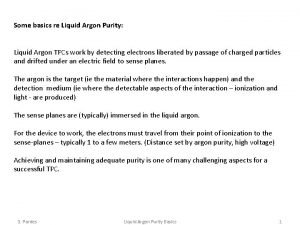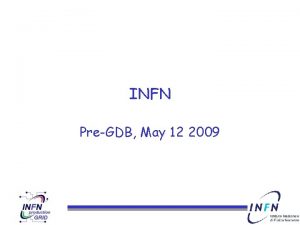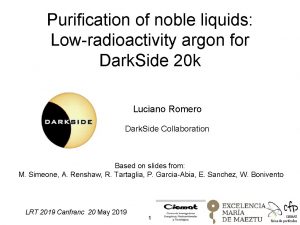Modular Argon purification and handling Claudio Montanari INFN


















- Slides: 18

Modular: Argon purification and handling Claudio Montanari INFN - Sezione di Pavia Claudio Montanari - Criodet 2 - LNGS June 14, 2007

Outline o Basic considerations o Standard procedures from ICARUS experience o Large volumes challenges o Dimensioning and design of purification systems for Modu. LAr o Conclusions Claudio Montanari - Criodet 2 - LNGS June 14, 2007 2

Basic Considerations o o o Considerable experience of the Icarus Collaboration has shown that free electron lifetimes of several milliseconds are currently realised with commercial purification systems based on Oxysorb. TM and molecular sieves. In order to ensure a free electron lifetime for the longest ≈ 3 ms fly path a vigorous purification of the LAr must be kept at all times: n In analogy with what is currently performed with T 600 and all previously constructed detectors, the purification must be performed both in the liquid and in the gaseous phase. The reference schemes developed so far within the Icarus Collaboration can be rescaled straightforwardly up to volumes of some thousands cubic meters. Claudio Montanari - Criodet 2 - LNGS June 14, 2007 3

Attainable Free Electrons Lifetime Free Electron Lifetime evolution during recirculation of 50 liters chamber Free electron lifetimes in excess of several milliseconds are routinely achieved with the standard procedures developed within the Icarus Programme. Present best result is in the range of 10 ms actually limited by our capability to measure longer lifetimes due to the limited size of the detector. Claudio Montanari - Criodet 2 - LNGS June 14, 2007 4

Basic Requirements Required Lifetime for 4 m drift ≈ 10 ms ≈0. 03 ppb (O 2 equiv) Required Lifetime for 2 m drift ≈ 5 ms ≈0. 06 ppb (O 2 equiv) Claudio Montanari - Criodet 2 - LNGS June 14, 2007 5

Basic Requirements Use of larger drift fields brings several advantages, including a reduction in the requirements for the free electrons lifetime. 1 k. V/cm could be attained rather easily for 2 m maximum drift corresponding to 0. 5 k. V/cm for 4 m maximum drift. Claudio Montanari - Criodet 2 - LNGS June 14, 2007 6

The Standard Icarus Procedure o The “standard” Icarus procedure for purification and handling LAr consists of 5 steps: 1. Use ultra high vacuum standards for detector components design, construction, cleaning and assembly; 2. Removal of air and outgassing of surfaces by evacuating the argon container volume to the molecular vacuum level (< 10– 3 mbar); 3. Fast cooling (to reduce pollution from outgassing) and filling with argon ultra-purified by means of chemical filters and molecular sieves; 4. Recirculation of the gas phase to block the diffusion of the impurities coming from the hot parts of the detector and from micro-leaks on the openings (typically located on the top of the device) in the bulk liquid; 5. Recirculation of the bulk liquid volume to further reduce the impurities concentration up to the required level. Claudio Montanari - Criodet 2 - LNGS June 14, 2007 7

Large volume challenges o Extrapolation of the standard Icarus procedure to volumes potentially very large (up to 10000 m 3 or more) is almost straightforward except for step 2 (evacuation to molecular vacuum of the detector volume). o A detector of several thousand m 3 is very hard to evacuate and a new method has to be applied. The idea is to perform successive flushing in the gaseous phase in order to attenuate the presence of gases other than Argon with an approximate exponential chain. o An improvement in the liquid purification system is also needed to enlarge in a significant way the TPC volume. New purification devices have to be implemented, possibly operating near or directly inside the detector. They should be simple, robust and without moving parts, to guarantee total reliability. Claudio Montanari - Criodet 2 - LNGS June 14, 2007 8

Large volume challenges (II) o Uniformity in the free electrons lifetime is a major issue for very large volume detectors. Convective motions provide a natural mechanism for mixing the liquid volume. For such a mechanism to be effective in providing uniformity of the liquid purity, liquid motions and the effect of the presence of the detector structures have to be carefully studied at the design level. Trapped volumes have to be avoided; the distribution network of the purification and recirculation system have to be designed accordingly. n In running conditions, monitoring of the uniformity of the liquid properties can be easily performed by means of cosmic muon tracks. n A number of dedicated devices (purity monitors) have to be installed in the non active zones (behind the wires and the race tracks) to complete the information and to check the purity during the initial filling and the startup phases of the detector. Claudio Montanari - Criodet 2 - LNGS June 14, 2007 9

Alternatives to vacuum (I) o o o Standard procedures, adopted to pre-condition industrial storage cryostats before first filling, reduce air concentration at the level of ppm in the gas phase, corresponding to ppm level in the liquid phase, after filling. These procedures are based on high rate flushing of the connecting pipes and of the container inner volume from the bottom to the top. Tests have been made by the ICARUS Collaboration to avoid high vacuum before filling: 1. With the 10 m 3 prototype, empty, no structures inside: high rate flushing of the connecting pipes plus compression / expansion cycles in the main volume: about 100 cycles from 1. 0 to 1. 1 bar, corresponding to 10 volumes exchange 5 ppm residual air concentration for perfect gas diffusion results from computation; Free electron lifetime after filling ≈ 30 µs. For these procedures to be effective, the geometry of the internal detector structures have to be carefully studied in order to eliminate trapped volumes (tubular elements, preferential flow paths, etc. ). This matches with the requirement for the uniformity of the liquid purity. Claudio Montanari - Criodet 2 - LNGS June 14, 2007 10

Simulations o o A detailed simulation of the basic Modu. LAr design has been performed using the Fem. Lab. TM code (a professional tool to solve gas transport problems). Several options have been considered: n n n o Gas injected on one side of the volume and extracted from the opposite side; Gas injected on the bottom of the volume and extracted from the top; Different flow rates. Results of the simulation indicate that the best solution consists in injecting the argon on the bottom of the container and extracting it from the top (due to the larger weight, argon concentrates on the bottom, pushing the air to the top): n few volumes (≈ 6) of gas flow are required to reach a residual air concentration < 1 ppm (< 1 ppb in the argon liquid phase). Claudio Montanari - Criodet 2 - LNGS June 14, 2007 11

Filling procedures T 600 Purification Unit • Filling rate should match the maximum supply rate of liquid Argon. Reasonable estimate for supply speed from a single dealer is ≈ 100 m 3 / day (5 trucks). This leads to a filling rate ≈ 4 m 3 / hour (6 at the design level); about 40 days will be necessary to fill a 4000 m 3 detector. • Single Hydrosorb. TM / Oxysorb. TM cartridge (type R 20, maximum size commercially available) like the ones used for the T 600 (see right): • Purification rate: 0. 5 m 3 / hour • Adsorption capacity: 40 normal liters of O 2 • The number of purification cartridges required for the initial purification of the liquid volume is correlated with the purity of the argon provided by the supplier. Very low Oxygen (and other contaminants) concentrations (small fractions of ppm or less) can be obtained at the production level and can be part Claudio Montanari - Criodet 2 - LNGS June 14, 2007 of the requirements of the supply contract. 12

T 600 purification Units Liquid recirculation pump Purification unit Claudio Montanari - Criodet 2 - LNGS June 14, 2007 13

A “self cleaning” cryostat n With a good control of the input heat and then of the convective motions, it could be possible to realize a “self cleaning” liquid circuit, collecting the LAr inside a number of “cleaning boxes” placed on the walls. n It is an improvement that will allow to avoid an external circulation. n For a 4000 m 3 liquid argon volume, a rate 240 m 3/day (6%/day or purification cycle of 16. 6 days) would allow to reach in 60 days the target purity (0. 03 ppb) if the initial e-negative concentration is at the level of 1 ppb (O 2 equiv. ). Claudio Montanari - Criodet 2 - LNGS June 14, 2007 cleaning n The mass of LAr moved is potentially very large. 14

Gas Recirculation System Recirculation of the gas phase is used to prevent diffusion of impurities coming from to hot parts of the detector and from openings (almost all located on the top) in the liquid volume. In this case the T 600 scheme can be used with no modifications. Gas recirculation scheme Required gas recirculation rate scales like the top surface of the liquid volume. Extrapolating from the T 600 case we have that, for an exposed surface of 9 x 51 m 2 (4000 m 3 Modu. LAr) there is a factor 6 surface increase with respect to the T 600. A gas recirculation rate of about 600 Nm 3 / hour will be required. Claudio Montanari - Criodet 2 - LNGS June 14, 2007 15

LAr Purity Monitor: working principle Lifetime Determination Claudio Montanari - Criodet 2 - LNGS June 14, 2007 16

T 600 purity monitor Read. Out Electronics R&D is in progress for new photocatodes to improve the sensitivity. Claudio Montanari - Criodet 2 - LNGS June 14, 2007 17

Conclusions o Free electron lifetimes of several milliseconds are required for the operation of 4. 5 kton or 9 kton Modu. LAr detectors. Such purities are routinely achieved using standard procedures developed within the ICARUS programme. o Extrapolation of the standard ICARUS procedures for the basic Modu. LAr designs is almost straightforward with one relevant exception: removal of air from the main argon volume and pre-conditioning of the internal surfaces before filling with LAr has to be done by high rate flushing of pure Argon gas. o For such a procedure to be effective, geometry of the internal detector structures must not contain trapped volumes. o Standard procedures used to pre-condition cryogenic storage dewars are able to remove air to the level required for the filling of the experiment. o Our simulations also demonstrate that a residual concentration of air in the argon volume of less than 1 ppm can be reached in less than one month with a rather modest gas flow rate. Claudio Montanari - Criodet 2 - LNGS June 14, 2007 18
 Duhhhhh
Duhhhhh Liceo statale carlo montanari
Liceo statale carlo montanari Alberto montanari
Alberto montanari Claudia montanari radiata
Claudia montanari radiata Protein characterization methods
Protein characterization methods Purification and characterization of organic compounds
Purification and characterization of organic compounds Vzácné plyny
Vzácné plyny Heat capacity at constant volume
Heat capacity at constant volume Argon fluoride laser could practical fusion
Argon fluoride laser could practical fusion Propiedades del argon
Propiedades del argon 1 mol
1 mol 23 na
23 na Argon pierwiastek
Argon pierwiastek Tignom
Tignom Sta su plemeniti gasovi
Sta su plemeniti gasovi What are bohr diagrams
What are bohr diagrams Propiedades fisicas y quimicas del argon
Propiedades fisicas y quimicas del argon Reaksi gas mulia
Reaksi gas mulia Argon classification
Argon classification
